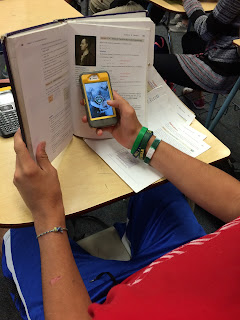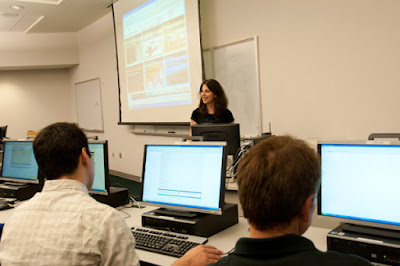 |
| Academic Integrity Infographic Photo Credit: Giulia Forsythe, Flickr |
Identifying the Issue
Technology is a pervasive force in our world today, and one that has become the bane of many a teacher’s existence. Although the potential for technology to augment and boost educational materials is monumental, the tendency for students to commit acts of academic dishonesty, either purposely or by accident, is not something that teachers can afford to ignore. As someone who considers myself to be very tech-savvy, I still find myself spending a great deal of time identifying and trying to put a stop to various types of electronic cheating. I believe that without guidance from their teachers, today’s teenagers have a natural tendency to lean toward taking the path of least resistance, but that much of the time they don’t actually know what constitutes cheating. I decided to research this topic because I am interested in what other teachers have discovered are the best ways to help our students make good academic choices.How Are Students Intentionally Electronically Cheating?
Students cheat in classes electronically both inside and outside the classroom, and do so in a variety of contexts and manners, from accessing information via smartphones during tests and lectures to viewing or even purchasing other students’ work online (Bain, 2015, p. 94-95). Thanks to 1 to 1 |
| Microprinted "Study" Materials Photo Credit: Ben Chun, Flickr |
Is Technology to Blame?
Tijana Zganec, a spokesperson for the company responsible for PhotoMath, answered this question for us when she astutely said (as quoted in Linshi, 2016), “We didn’t develop PhotoMath as a cheating tool. We really wanted kids to learn. If you want to cheat, you will find a way to cheat. But if you want to learn, you can use PhotoMath for that.” The same can be said for any online academic assistance or enrichment materials, whether the information is being put to its intended purpose ornot. Companies with unsavory intentions are going to exist in the world, but is their very existence tempting students to engage in academically dishonest behavior?
 |
| Off Task and Online Photo Credit: Intel Free Press |
When Cheating is Unintentional
 |
| Technology Integration in Schools Photo Credit: San José Public Library, Flickr |
An increasing number of adults are filtering into this category as well, especially since, “the application of computer technology to virtually every field of study has changed the way work is done today” (Barr et al., 2011, p. 23). It is not difficult to forget that, “we use technology every day to assist us. We take technology like eyeglasses for granted even when we still argue about the use of calculators or computation engines in the classroom (Martinez & Stager, 2009, Kindle Locations 3769-3771). As our technology evolves, it stands to reason that our parameters for its use should evolve as well.
Despite having a reputation for technology savviness, “a number of studies have shown there are gaps in the digital knowledge and skills of young people. A recent study from Stanford researchers found that K–20 students in the US are unprepared to judge the credibility of news and information they come across in their daily lives” (Freeman et al., 2017, p. 28). It is no wonder that secondary students struggle with maintaining their integrity as they find information and decide what to do with it. In my position of English teacher, I have watched the ebb and flow of my students’ skills for over a decade, and I can say with assuredness that my students know less about what constitutes plagiarism, attribution, and digital theft with each passing year.
 |
| Plagiarism is No Joke Wikimedia Commons |
This is not to say that this behavior should be excused, but that students need to be encouraged to approach the conundrum of how to use the information that they find just as they would any other problem that needs to be solved. As we hone their iterative thinking skills, “we need to ensure that all students have the opportunity to learn the complete set of skills so their combined power is available to them” (Barr et al., 2011, p. 23). Students need guidance as they develop the sturdy digital citizenship that they will require as adults. The type of cheating that I see the most often in my own classes is plagiarism of written materials. Some of it is intentional, and often borne out of procrastination that gives rise to panic. Most of it, however, unintentional, and due to improper or missing citations, or incorrectly formatted paraphrases. Because I want my students to be as independent as possible, and because I believe in the importance of computational, iterative thinking, I will often encourage students to seek out online citation information (such as Purdue Online Writing Lab), and attempt to revise their citations themselves before I interfere.
How Do We Help Students Make Good Choices?
In the grand scheme of things, what can teachers do about cheating? According to Lisa Bain (2015), there are several tried-and-true methods to discourage students from committing acts of academic dishonesty that build all the way up to barring students from bringing their own devices to class, but I believe that the most compelling one that she puts forth is educating students about what constitutes academic dishonesty in the first place. It is our obligation to ensure that students have the tools that they need to be successful, responsible members of our society, and scolding them for making mistakes is not going to encourage the kind of growth that we need to see in them. It may feel rather painstaking to help students navigate the minutiae of digital citizenship and integrity, but it is work that is well worth the time spent.Above all, the most critical thing that we can do for our students as we help them to strive to become or remain good people is to build relationships with them. The way that we encounter and deal with instances of academic and electronic dishonesty will leave a lasting impression on the students involved. In their study, Simkin and McLeod (2010) analyzed their survey data with the express intention of searching for a reason for students not to cheat, and they “identified only one statistically significant deterrent: ‘moral beliefs’” (p. 447). It is not always possible to direct a student’s moral compass, but stopping to understand why it may be pointing in the direction it is, and responding accordingly is a teacher’s best recourse. “There is no faster way to completely destroy the relationship that you had with a student than to do the right thing by catching them doing the wrong thing” (Haaheim, 2013). Especially in cases where a student cheated unintentionally, the teacher’s sensitivity to the situation can make a huge difference in future behavior.
Resources
Bain, L. Z. (2015). How Students Use Technology to Cheat and What Faculty Can Do about It. Information Systems Education Journal, 13(5), 92-99.
Barr, D., Harrison, J., & Conery, L. (2011). Computational Thinking: A Digital Age Skill for Everyone. Learning & Leading with Technology, 20-23.
Freeman, A., Adams Becker, S., Cummins, M., Davis, A., and Hall Giesinger, C. (2017). NMC/CoSN Horizon Report: 2017 K–12 Edition. Austin, Texas: The New Media Consortium.
Haaheim, A., & TedxYouth. (2013, December 02). Cheating Can Be a Good Thing: Andrew Haaheim at TEDxFridleyPublicSchools. Retrieved November 8, 2017, from https://www.youtube.com/watch?v=0IJ5zITWsF4
Linshi, J. (2016, June 17). Homework Answers: 7 Apps That Will Do Your Homework For You. Retrieved November 9, 2017, from http://time.com/3545695/homework-answers-apps/
Martinez, Sylvia Libow & Stager, Gary (2009). Invent To Learn: Making, Tinkering, and Engineering in the Classroom. Constructing Modern Knowledge Press. Kindle Edition.
Simkin, M.G. & McLeod, A. (2010). Why Do College Students Cheat?. Journal of Business Ethics. Retrieved November 9, 2017, from https://doi-org.prxy4.ursus.maine.edu/10.1007/s10551-009-0275-x
Comments
Post a Comment